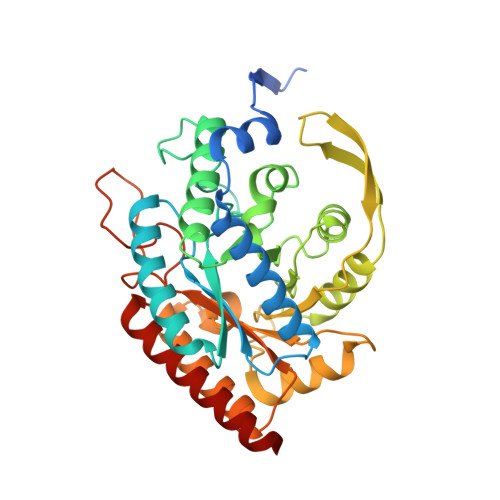Substrate and Metal Complexes of 3-Deoxy-D-Arabino-Heptulosonate-7-Phosphate Synthase from Saccharomyces Cerevisiae Provide New Insights Into the Catalytic Mechanism.
Koenig, V., Pfeil, A., Heinrich, G., Braus, G., Schneider, T.R.(2004) J Mol Biology 337: 675
- PubMed: 15019786
- DOI: https://doi.org/10.1016/j.jmb.2004.01.055
- Primary Citation of Related Structures:
1OAB, 1OF8, 1OFA, 1OFB, 1OFO, 1OFP, 1OFQ, 1OFR - PubMed Abstract:
3-Deoxy-D-arabino-heptulosonate 7-phosphate (DAHP) synthases are metal-dependent enzymes that catalyse the first committed step in the biosynthesis of aromatic amino acids in microorganisms and plants, the condensation of 2-phophoenolpyruvate (PEP) and d-erythrose 4-phosphate (E4P) to DAHP. The DAHP synthases are possible targets for fungicides and represent a model system for feedback regulation in metabolic pathways. To gain further insight into the role of the metal ion and the catalytic mechanism in general, the crystal structures of several complexes between the tyrosine-regulated form of DAHP synthase from Saccharomyces cerevisiae and different metal ions and ligands have been determined. The crystal structures provide evidence that the simultaneous presence of a metal ion and PEP result in an ordering of the protein into a conformation that is prepared for binding the second substrate E4P. The site and binding mode of E4P was derived from the 1.5A resolution crystal structure of DAHP synthase in complex with PEP, Co2+, and the E4P analogue glyceraldehyde 3-phosphate. Our data suggest that the oxygen atom of the reactive carbonyl group of E4P replaces a water molecule coordinated to the metal ion, strongly favouring a reaction mechanism where the initial step is a nucleophilic attack of the double bond of PEP on the metal-activated carbonyl group of E4P. Mutagenesis experiments substituting specific amino acids coordinating PEP, the divalent metal ion or the second substrate E4P, result in stable but inactive Aro4p-derivatives and show the importance of these residues for the catalytic mechanism.
Organizational Affiliation:
Department of Structural Chemistry, University of G?ttingen, Tammannstr. 4, D-37077 G?ttingen, Germany.

















